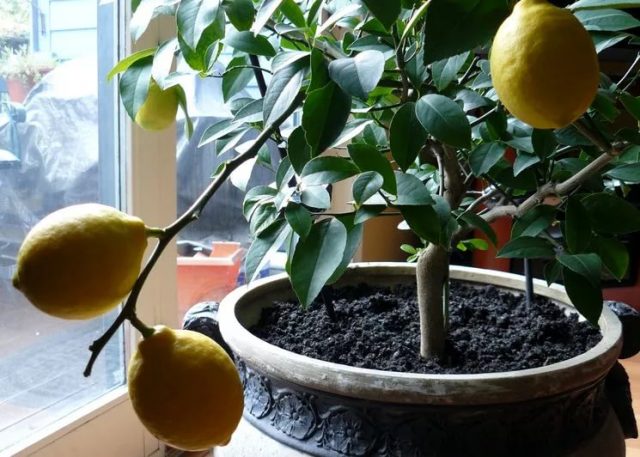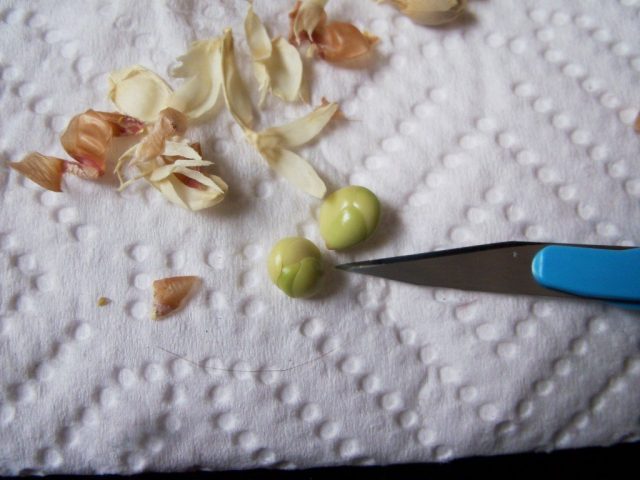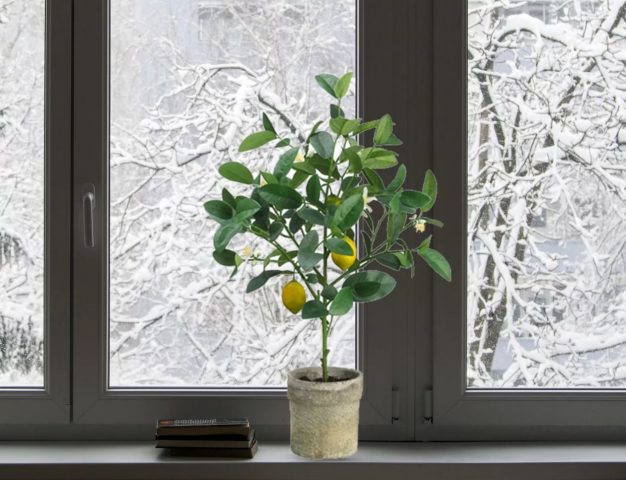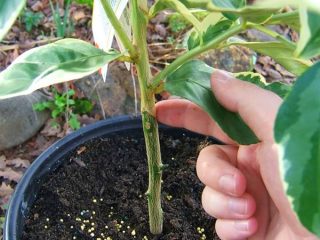Content
Lemon is an evergreen tree with yellow fruits, the peel of which contains a large number of veins filled with essential oils. This explains the characteristic lemon smell. Lemon belongs to the Citrus genus. India and the Pacific Islands are considered the homeland of this tree. The shrub is cultivated in countries characterized by a subtropical climate. Growing a lemon from a seed at home is quite difficult.In order to get not a decorative, but a fruit-bearing tree, you must strictly follow the rules of planting and maintenance.
Is it possible to grow lemon from a seed at home?
One of the methods is suitable for growing indoor lemons at home: you can purchase seedlings in a specialized store or try to grow lemons yourself on a windowsill from a seed.
Lemon trees are most often found in offices, retail premises or residential buildings in the form of an ornamental shrub. Growing a lemon tree at home so that it bears full fruit is a complex and lengthy process. Ornamental trees are not able to form ovaries and bear fruit. The leaves of ornamental lemons are usually dark green and have only a hint of the characteristic aroma that everyone is familiar with. Nevertheless, planting a lemon at home from a seed and waiting for the fruit to appear becomes possible if you follow the necessary agrotechnical care rules.
Will a lemon grown from a seed bear fruit?
The fruiting of a tree depends on several conditions; failure to comply with one of them can lead to the bush remaining decorative.
Conditions necessary for possible fruiting:
- Strict adherence to temperature conditions. This is one of the basic rules for growing a lemon tree. Citrus does not tolerate temperature changes well, and also cannot exist in an environment where the temperature drops below +10 °
- Vaccination. This method significantly increases the lemon tree's chances of bearing fruit. Grafting is carried out by budding or placing the rootstock in a split.
- Providing daylight for at least 12 hours.
- Regular watering.
- Carrying out the necessary fertilizing.
Compliance with all of the above conditions makes it possible to obtain a harvest of lemons in the 3rd to 5th year of the existence of this evergreen tree in the apartment.
Lemon varieties for growing at home
To grow citrus from a seed, you need to choose the right variety and organize care to ensure the plant bears fruit when its natural habitat conditions change.
The most suitable varieties for home cultivation are:
- Anniversary — leader in growing at home, including on apartment loggias;
- Pavlovsky - one of the most popular varieties, up to 2 m high;
- Genoa - specially bred for growing indoors, 1.5 m high with fruits that are most reminiscent of classic lemons;
- Meyer - a hybrid of lemon and grapefruit, height 1.5 - 2 m, feature - seasonal rest;
- Panderosa - up to 1.5 m with medium-sized lumpy fruits.
How to grow lemon from a seed at home
After choosing the lemon variety to grow, they begin to select the fruits. They should be ripe, smooth, uniform in color with the skin without damage or dents.
The most suitable time period for placing a seed in the ground is considered to be the end of spring or the beginning of summer. This time creates a natural atmosphere that is comfortable for the germination of lemon seeds to begin:
- presence of long daylight hours;
- establishing a stable air temperature;
- impossibility of drying air in apartments due to the end of the heating season.
These are favorable conditions for growing a viable lemon tree. During the first stage, the seed should take root and germinate. Then the stage of caring for the appendage begins.If you follow the rules, after a year a lemon tree will grow from the seed. Several years pass before fruiting and flowering. This period is important for the seedling as a stage of adaptation and formation. During this period of time, the lemon adapts to room conditions and gets used to changes in temperature conditions. In the 4th – 5th year of existence, a tree up to 3 m is formed from a lemon sprout, while dwarf varieties for growing in apartments do not exceed 2 m.
Leaves on shrubs live for about 3 years; as they age, they gradually change. The buds develop for about 5 weeks and then begin to bloom. The flowering of citrus fruits is considered protracted, lasting up to 10 weeks. Under indoor conditions, the time period from the beginning of the formation of the ovary to the ripening of the fruit can take about 230 days.
To get a harvest of lemons, you must carefully ensure that the tree does not shed its leaves during the growing season. The fact is that there is a close relationship between the number of leaves on the branches and the number of fruits produced. For fruit development, a lemon must have 8 to 10 true active leaves. The main task of the gardener who hopes to get a harvest is to preserve the leaf blades of the lemon. This crop is characterized by year-round fruiting. Citrus blooms regardless of the time of year. With proper care and compliance with the necessary conditions, domestic trees live up to 30 - 40 years.
How to plant a lemon from a seed at home
Planting a lemon from a seed at home involves several steps. Each of them is an important stage of cultivation.
Preparing the container and soil
At the first stage of cultivation, when it is necessary to root a lemon seed and grow a shoot, small plastic containers are chosen, the height of which does not exceed 5 - 6 cm.
After the emergence of seedlings, at the stage of active growth, they are transplanted to a permanent place, which will be a home for the lemon until it has to be replanted again.
The size of the first lemon pot should be several centimeters larger than the container in which the seeds grew. To grow a lemon tree from a seed at home, clay pots are often chosen.
Benefits of clay pots:
- clay material is well suited for growing citrus fruits due to its ability to absorb moisture, the pores of the walls actively absorb it and save the plant from waterlogging;
- the pots are stable due to the heaviness of the material, which eliminates the possibility of the tree tipping over.
Advantages of plastic lemon pots:
- the root system of the plant does not grow into plastic walls;
- ease of maintenance of containers;
- protection against overheating and hypothermia of the root system due to the inability of plastic to conduct heat.
Advantages of wooden pots:
- suitable for mature trees;
- Strong, durable, stable;
- protect the lemon from excess moisture.
The size is selected based on the following calculations:
- annual citrus seedlings are grown in containers with a diameter of no more than 5 cm;
- when changing the pot, take into account an increase in diameter by 3 - 5 cm.
Characteristics of soil mixture suitable for growing citrus fruits:
- loose structure;
- acidity level is weak or neutral;
- the presence of nutrients with a high phosphorus content.
Before planting, prepare the container as follows:
- A mandatory layer of drainage is placed at the bottom of the pot. Expanded clay or vermiculite are suitable for this.
- Then pour a layer of prepared soil, not reaching 2 cm to the edges of the container.
- The soil is moistened with a sprayer.
- Prepare dry soil to cover the seed with a 1 cm layer on top.
Can lemons be planted in regular soil?
Regular soil is not suitable for indoor citrus trees for many reasons. It is impossible to grow lemon in it due to the reduced nutrient content. Uneven particles can also be found in the soil, and the root system of lemons is designed in such a way that it is unable to quickly absorb nutrients.
How to prepare lemon seeds for planting
Before planting lemon seeds, you need to select and prepare them. Select whole, even, undamaged seeds from freshly cut lemons. Before planting, they undergo special treatment. The seeds are immersed in a growth stimulator and left for 12 hours.
The soaking solution is prepared from 250 ml of water and 1 drop of biostimulant. Such drugs as Zircon, Kornevin are suitable for this. This procedure increases germination. Experienced gardeners do not place seeds in solutions with root stimulants before planting, and also do not soak them in water. They free the seeds from the hard outer shell and immediately bury them in the soil. When removing the hard shell, special care must be taken not to damage the lemon cotyledons.This procedure, according to gardeners, should speed up the germination process, and there are no special recommendations for seed stratification.
How to germinate lemon seeds at home
The seed is placed in the soil to a depth of no more than 2 cm. To create a greenhouse effect that will increase germination, containers with planted seeds are covered with plastic wrap or the top half of plastic bottles.
The temperature for germination should not be lower than +18 °C. The soil in which the seeds are to be grown is not watered in the usual way. For irrigation, use a spray bottle to gently moisten the top layer of soil. After the sprouts appear, the soil continues to be moistened in the same way. Plastic or polyethylene is removed after the appearance of the 4th true leaf.
During the germination period, seedlings need diffused light: direct sunlight is completely excluded. For irrigation, use water that has been standing in the room for several hours.
How to plant lemon seeds at home
To grow a full-fledged tree, seedlings are transplanted to a permanent place of growth after the appearance of the 3rd or 4th leaf. The transplantation process can be divided into several stages:
- Water the lemon generously, then, holding the shoot near the base, carefully turn the pot over, and pull the plant out of the container along with the soil.
- Transshipment is carried out by first loosening the earthen ball with a wooden stick to facilitate adaptation of the root system.
- The roots are powdered with a root stimulator (Kornevin or Zircon).
- Place the lemon in a new pot equipped with a drainage system, then fill in the soil around the main trunk.
- The pot is shaken to allow the soil to settle, then watered generously with water at room temperature.
- After transplantation, the leaves are sprayed with a spray bottle and removed to a shaded place so that the lemon quickly adapts to new conditions.
How to Grow a Lemon Tree
Transplanting a lemon seedling to a permanent place of growth is the beginning of a difficult and lengthy process of growing a full-fledged lemon tree in a pot at home. During the growing season, gardeners recommend adhering to basic rules, which include carrying out agrotechnical practices designed only for citrus crops.
How long does it take for lemon seeds to germinate?
The time intervals including germination and transplantation depend on the temperature and the required daylight hours.
Germination time at temperatures from + 25 °C to + 28 °C | Germination time at temperatures from + 18 °C |
10 - 15 days | Up to 5 weeks |
It takes 1 to 3 weeks for the transplanted seedling to adapt, after which the plant grown from the seed begins to actively develop, gradually turning into a small tree with a developed crown and a faint lemon aroma. With proper care, the flowering period can occur in 3 to 5 years.
Watering schedule
Citrus crops react to excess moisture with fungal diseases of the root system, so gardeners recommend watering the plants, focusing on the condition of the soil. Water for irrigation must be settled. To improve the quality, add 3 ml of nitric acid to 10 liters of liquid; this mixture helps to avoid the ingress of chlorine from tap water.
When and what to feed
Lemon feeding begins a month after transplantation to a permanent place of growth, then it is applied 2 times a month.
To fertilize the roots, solutions of organic complexes are used. The lemon root system needs nitrogen-containing mixtures, as well as phosphorus and potassium during the period of flower stalk setting and fruit formation.
Trimming
To grow a full-fledged lemon tree, crown formation begins at an early age. Principles of pruning:
- The top is pinched to ensure lateral branching.
- Regularly turn the lemon 10 degrees so that the branches do not develop to one side.
- Lemon pruning is carried out throughout the year, as needed.
Creating suitable conditions
To grow, citrus crops need stability in providing vital conditions.
- Lighting. Avoid exposure to direct sunlight to prevent burns to the leaf plates. When there is not enough lighting, the lemon is provided with additional lighting with fluorescent lamps.
- Humidity. Citrus fruits are intolerant of increased dry air. For normal development, they need air with humidity levels of at least 45 - 50%. To increase humidity, humidifiers are placed near pots.
- Temperature. To grow lemons, you need to maintain temperature conditions. For the warm season, maintaining the temperature between 18 °C and +23 °C is suitable; in winter, the temperature for growing lemon should not fall below +10 °
Features of growing lemon in an apartment in winter
The most difficult period for gardeners in growing lemons is winter. Plants enter a resting phase. In winter, the watering regime is reduced and heated water is used.
At this time, it is necessary to combat dry air due to heating. Overdrying leads to the fact that the lemon begins to shed its leaves, so gardeners recommend achieving air humidity by any available means. When a lemon is resting, it does not need feeding. It only needs additional lighting if the light becomes insufficient.
List of possible problems when growing lemons
Dropping leaves, yellowing of the tips of the blades, wilting, rotting of the roots - this is not a complete list of signs of a citrus tree’s response to errors in care or the appearance of pests.
The condition of the leaves can indicate a lack of nutrients:
- dryness at the ends indicates the need to supplement phosphorus to the roots;
- a lack of potassium or magnesium affects the leaves by the appearance of wrinkles and the fall of the newly formed ovary;
- yellowness of the leaves appears as a response to waterlogging;
- a stunted and diseased appearance may indicate rotting of the root system.
With regular inspection of the lemon, you can promptly notice the appearance and reproduction of parasitic insects. The dangers that threaten indoor lemons lie in the appearance of several varieties that are characteristic of spreading on indoor plants:
- Mealybugs. These are parasites that arise as a result of excessive dry air; they can be removed by regularly washing the leaves, cleaning them from dust and moisturizing them using available methods.
- Scale insects. Pests multiply on the leaves and stem due to excessive moisture; their appearance can be identified by the formation of shiny sticky drops; at the next stage, the lemon begins to shed its leaves.Scale insects are removed by treating parts of the plant with a solution of laundry soap. The treatment is carried out every 2 days, after which the lemon is given a hygienic shower.
- Spider mite. This is an insect that often appears on indoor plants. It can be detected by the presence of a white thin web on the lemon. The tree is treated with sulfur, the leaf plates are washed with jets of water or sprayed with a soap solution.
Preventive measures to combat parasites and diseases:
- hygienic shower with hot water;
- spraying leaves on both sides;
- treatment with Fitosporin.
Some tips for growing lemon
- Experienced flower growers advise to be patient in the first year of lemon flowering and rid the tree of the buds that appear. This will help preserve the tree's strength to produce full-fledged fruits for the next season.
- According to gardeners, the eastern side is most suitable for growing lemons on a windowsill in an apartment.
- For the formation of 1 flower, at least 10 viable leaves are required, so it is necessary to monitor leaf formation from a very early age of the seedling.
- In winter, containers filled with water are placed next to the pot. This helps maintain air humidity at the required level.
- Pruning on all branches is carried out after the appearance of the 5th leaf: in this way, the crown of the tree is formed compact and aesthetically attractive.
- To increase efficiency, 5-8 seeds are buried in the soil, then the strongest seedlings are selected.
Conclusion
It is quite possible to grow a lemon from a seed yourself. To do this, you should choose the right variety and take into account that citrus requires constant care.By creating comfortable conditions for the plant, you can not only get a beautiful tree as a spectacular element of your home interior, but also get a full and regular harvest of bright, vitamin-rich fruits.


















